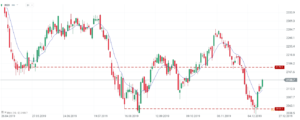Disappointing global prosperity. How will the Polish economy be found in it?
Recent events related to the signing of the agreement, with the clear date of UK exit from the EU, have put markets in good spirits. Today and yesterday's macroeconomic data releases poured a bucket of cold water on investors' heads. Despite the fact that Donald Trump boasts of new historical highs and good condition of stock exchanges, the economic reality does not look so impressive anymore. I do not want to speak here about the word often overused (and recently fashionable) crisis, although it would be appropriate to say about the continuing slowdown in key economies of the world. How will all this affect the Polish market and do we have anything to worry about?
Who was at fault?
Even at the beginning of 2019, when publishing the first, already mixed macroeconomic data, a large proportion of analysts pointed to one problem. According to many, the shape of indicator readings (mainly industrial ones) was influenced by new emission standards and laws. This concerned, among others, European countries. The forecast was that while these changes were being made, the US economy would catch more wind in its sails, and the European economy would quickly acclimate to new changes. Looking at all this in retrospect, emission standards were only one of many components that affected the slowdown.
Be sure to read: How much will we lose in the US-China trade war?
It is worth noting that problems with economic stagnation do not only apply to Europe and Germany, which are pushing ahead. A slower pace this year was also recorded by the Asian industry, whose problems began with the turmoil on the US-China line. The United States, despite Donald Trump's strenuous efforts to make his country a green "anti-recession" island, has also slowed down.
Consumer is a godsend from the crisis?
A strong consumer is a godsend for the current economic situation. It is thanks to him that we do not have a deeper recession. Nevertheless, the data remain alarming, and central banks are in no hurry to intervene, thinking it is too early. Apart from the rhetoric of central banks and their assessment of the situation, it is currently difficult to find a factor that could stimulate growth again. The consumer alone will not be able to create enough purchasing power to completely absorb industrial and service goods. The upside is, however, that orders have a lower decline dynamics.
What does the Polish economy say?
It is nothing new or revealing that the Polish economy is strongly correlated positively with the German economy. The weakness of the neighbor's western industry does not bode well. In fact, we can already observe the first signs of a loss of growth. I emphasize again that this is not the same as talking about a total recession. Despite what Germany has recently presented, our country has developed (perhaps only for now) some immunity.
It is not surprising also that the recession is necessarily a natural phase of the business cycle, so it will occur sooner or later. Fears in this respect can only be its size and strength. What is currently happening in global economies will not deepen. All estimates of when it actually occurs are a little blind. It is worth adding that no central bank yet assumes a decline in GDP below 0. Looking at long-term forecasts, they assume an increase in price growth near assumed inflation targets.
Read also: Foundations on Forex - introduction. Interest rates and GDP [part 1]
In the context of Poland, we can talk about the fulfillment of the deep slow-down scenario than the crisis of the century. Current macroeconomic data releases are not yet alarming, but they show the first signs of a downturn. Practically, since December 2018, PMI for industry has not broken the threshold of 50 points, and in October it fell to 45,60 points. In theory, a level of 50 points is key to assessing growth potential. New orders are in a downward trend, their lowest threshold this year was exactly 95,2 in the summer. They are constantly balancing at levels above 100. Is it enough, however, for Poland to avoid a deeper slowdown in a wide arc?






















![Forex Club – Tax 9 – Settle tax on a foreign broker [Download the Application] Forex Club - Tax 9](https://forexclub.pl/wp-content/uploads/2024/02/Forex-Club-Podatek-9-184x120.jpg?v=1709046278)
![Trading View platform – solutions tailored to the needs of traders [Review] trading view review](https://forexclub.pl/wp-content/uploads/2024/03/trading-view-recenzja-184x120.jpg?v=1709558918)
![How to connect your FP Markets account to the Trading View platform [Guide] fp markets trading view](https://forexclub.pl/wp-content/uploads/2024/02/fp-markets-trading-view-184x120.jpg?v=1708677291)
![How to invest in ChatGPT and AI? Stocks and ETFs [Guide] how to invest in chatgpt and artificial intelligence](https://forexclub.pl/wp-content/uploads/2023/02/jak-inwestowac-w-chatgpt-i-sztuczna-inteligencje-184x120.jpg?v=1676364263)


![WeWork – the anatomy of the collapse of a company valued at $47 billion [WeWork, part II] wework bankruptcy story](https://forexclub.pl/wp-content/uploads/2024/04/wework-bankructwo-historia-184x120.jpg?v=1711729561)
![Adam Neumann – the man who screwed up Softbank [WeWork, part AND] adam neumann wework](https://forexclub.pl/wp-content/uploads/2024/04/adam-neumann-wework-184x120.jpg?v=1711728724)





![How to transfer shares to another brokerage office [Procedure description] how to transfer shares to another brokerage house](https://forexclub.pl/wp-content/uploads/2024/03/jak-przeniesc-akcje-do-innego-biura-maklerskiego-184x120.jpg?v=1709556924)

![The most common mistakes of a beginner trader - Mr Yogi [VIDEO] Scalping - The most common mistakes of a beginner trader - VIDEO](https://forexclub.pl/wp-content/uploads/2024/03/Scalping-Najczestsze-bledy-poczatkujacego-tradera-VIDEO-184x120.jpg?v=1711601376)
![Learning patience: No position is also a position - Mr Yogi [VIDEO] Scalping - Learning patience - No position is also a position - VIDEO](https://forexclub.pl/wp-content/uploads/2024/03/Scalping-Nauka-cierpliwosci-Brak-pozycji-to-tez-pozycja-VIDEO-184x120.jpg?v=1710999249)
![When to exit a position and how to minimize losses - Mr Yogi [VIDEO] Scalping - When to exit a position and how to minimize losses - VIDEO](https://forexclub.pl/wp-content/uploads/2024/03/Scalping-Kiedy-wyjsc-z-pozycji-i-jak-minimalizowac-straty-VIDEO-184x120.jpg?v=1710336731)



















